Suppose you’re an app developer who wants to ensure that your app is optimized to function well on 80% of the individual connected devices currently in use (e.g., my iPad, your Windows phone). How many different device models (e.g., Kindle Fire HD 8.9" Wi-Fi, Galaxy S III) do you think you need to support? 156. Maybe you’re okay with having your app optimized for only 60% of active devices. That still means that you need to support 37 different devices. Even getting to 50% means supporting 18 devices, as shown below. If you’re a large or particularly thorough app developer, reaching 90% of active devices will require supporting 331 different models.
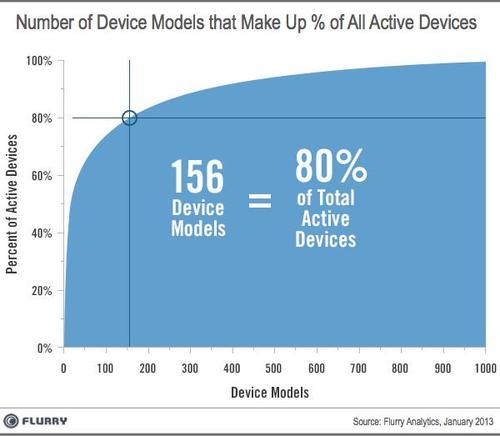
The dominance of iOS and Android platforms has obscured the proliferation of connected device models. During January, Flurry detected 2,130 different device models with active users (defined as having app sessions during January), including 500 different device models with at least 175,000 active users.
Using the 80/20 rule, the market for devices might even seem concentrated: just over 7% of device models account for 80% of active users. Still, the large total number of device models in use poses challenges for developers.
It’s obvious that different apps are required for different platforms. Developers can choose to serve only a portion of the app market by developing apps for only a subset of operating systems (and consequently a subset of device models). Even having made that choice, though, adaptations may be required to accommodate different versions of the same platform (e.g., iOS 6.x versus iOS 5.x, forked versions of Android, etc.), smartphones versus tablets and the increasingly wide variety of screen sizes and aspect ratios in which those devices are now available.
Developing apps on the device models that represent the majority of devices currently in active use has become an expensive and time-consuming process. Not optimizing or testing apps on devices being used by even a minority of people exposes developers to negative user experiences and potentially to buying expensive devices to troubleshoot problems as they arise.
This fragmentation has the potential to change the app ecosystem by making it harder for small developers to compete since they are unlikely to have the resources to support the growing list of device models currently in use. They may also be disadvantaged in economies of scale in promotion (including word of mouth) if their apps are not available or do not work well on most device models. Scale is likely to be increasingly important when it comes to app development and that may lead to consolidation within the app development industry.
Developer surveys, such as Vision Mobile’s, consistently show that the revenue distribution for app developers is highly skewed: only a minority of developers make more than $500 per app per month. The increasing need for scale to ensure full functionality on the full range of connected device models in use may help explain why. The growing challenge of discoverability in an increasingly crowded app market is also likely to be part of the explanation.
So what is a small developer to do? One strategy is to focus on the device models used by the greatest number of people. Surveys consistently show that developer commitment to iOS is disproportionately strong relative to the market share for iOS devices. Our results suggest this trend is probably a consequence of developers seeking efficiency (the most users for the least work) because device models running on the iOS platform average 14 times the number of active users than device models running on other platforms. This is shown in the chart below in which the average number of active users for device models running on different operating systems are indexed to Android (where Android = 1).
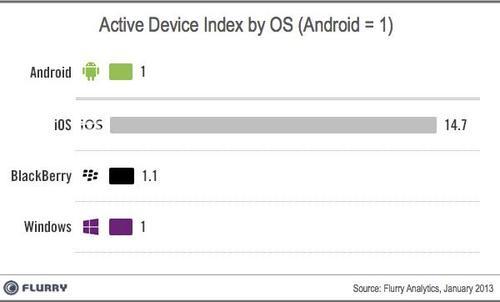
It’s difficult to fully disentangle platform from manufacturer and comparing devices made by Apple to devices made by the three other device manufacturers with the greatest average number of active users per device model tells a similar story. This is shown in the chart below – this time indexed so the average number of active devices per Samsung device model = 1. As shown in the chart, on average Apple device models have more than seven times as many active users as Samsung device models and more than four times as many as Amazon device models.
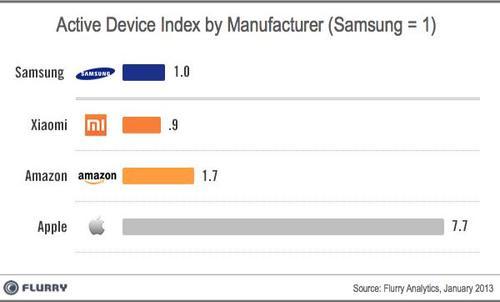
Of course, some people use their devices more than others and many developers prefer to target heavier app users. So what about app sessions? They are somewhat more concentrated than active devices. As shown below, for developers to ensure they were optimized on the devices responsible for 50% of app sessions conducted during January, they would have needed to support only eight different device models and to cover 80% of sessions they would have needed to support 72 different device models. That’s still a lot of device models, but it’s less than half the device models required to reach 80% of active devices.

In addition to having more active devices per device model than other platforms, iOS device models average more app sessions per active device than device models running on other platforms. This is shown below, again using an index for which app sessions per active Android device are set to one. This further clarifies why developer support for iOS is disproportionate to iOS’ share of the installed device base. Developers can reach more active devices by developing for a smaller number of device models on iOS and they can also capture the attention of very active users. People who have iOS devices tend to have more app sessions, creating more opportunities for in app purchases, advertising revenue and paid app purchases.
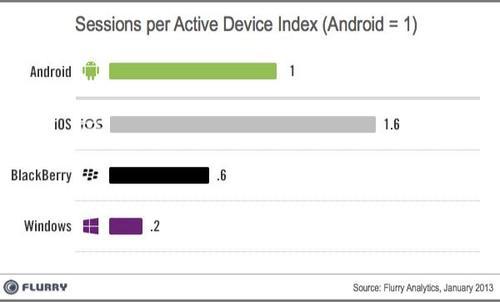
Viewed at the manufacturer level, Apple device models average more sessions per device than device models made by the other manufacturers previously shown. This is shown below, again indexed so that average sessions per Samsung device = 1.
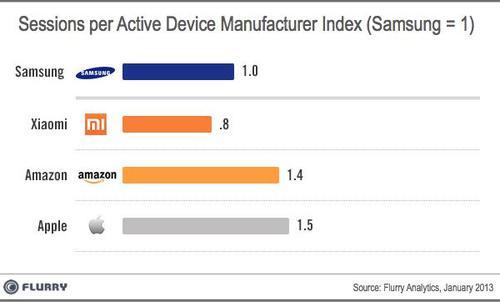
With competition in the device market heating up, manufacturers seem likely to fill and expand product lines with an increasing number of devices intended to differentiate themselves and address the preferences of specific types of users. That implies that it will only become more difficult for developers to optimize, test and support their apps for use on all device models. And yet doing exactly that is likely to be increasingly important for app developers given the market for apps is also becoming more crowded and more competitive, making negative user experiences more damaging. Promoting apps and leveraging that investment in promotion across as many potential users as possible will also become all the more critical. Putting all of this together, we expect a future in which app developers are less frequently individuals with a creative idea and a laptop and more frequently, companies designed to develop, produce and distribute apps at scale.